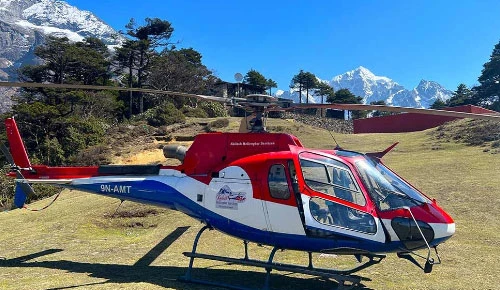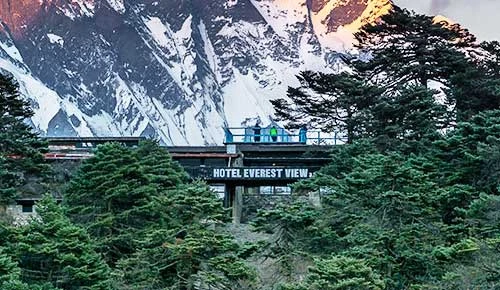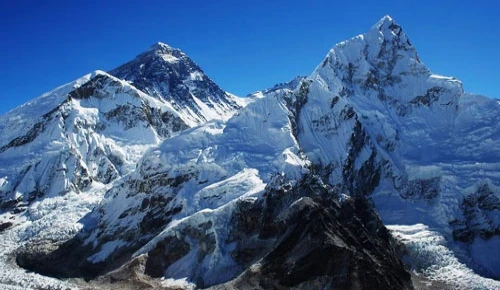How to do Everest Base Camp Trek?
Trekking to Everest base camp is an incredible 14 days adventure that takes you to the base camp of the world's highest mountain, Mount Everest. It's located in Nepal's Khumbu region and offers breathtaking views of the Himalayas, peaceful landscapes, and a chance to immerse yourself in the Sherpa culture. While it's a challenging trek, it's also incredibly rewarding and attracts adventurers from all over the world.
This trek is significant because it's linked to the history of mountaineering and the appeal of being at the foot of Everest. By doing this trek, you can experience the awe-inspiring beauty of the region and follow in the footsteps of legendary mountaineers. The journey provides both a physical and mental challenge, but it also gives you a great sense of accomplishment and a deep connection with nature.
For the best experience, it's recommended to go on the trek during the spring (March to May) or autumn (September to November) seasons. These times offer stable weather, clear skies, and pleasant temperatures. Spring brings colorful rhododendron blooms, while autumn provides post-monsoon clarity and incredible mountain views.
To prepare for this trek, it's important to get the required permits and follow the regulations. You'll need a Sagarmatha National Park Entry Permit and a Trekkers' Information Management System (TIMS) card, which you can get in Kathmandu or through authorized agencies. Respecting the local culture, traditions, and environment is essential during the trek. It's also important to follow guidelines for responsible tourism and waste management to protect the natural beauty of the Everest region for future generations.
Table of Contents
Preparation of the trek
Preparing for a trek requires careful planning and preparation to ensure a smooth and enjoyable experience. Here are the key aspects to focus on:
Physical fitness and training:
- Start training well in advance to build endurance and strength.
- Incorporate cardio exercises like hiking, running, or cycling to improve stamina.
- Include strength training exercises to strengthen your leg muscles.
- Practice uphill and downhill walking to simulate the trekking conditions.
- Consult with a healthcare professional before starting any intense training program.
Packing essentials:
- Lightweight and durable backpack to carry your belongings.
- Sleeping bag suitable for cold weather conditions.
- Trekking boots with good ankle support and a sturdy sole.
- Layered clothing for various weather conditions, including thermal innerwear, trekking pants, waterproof jacket, and fleece jackets.
- Moisture-wicking socks and gloves.
- Hat or beanie to protect from the sun and cold.
- Sunglasses with UV protection.
- Headlamp or flashlight with extra batteries.
- Trekking poles for stability and reducing stress on joints.
- Water bottles or hydration system to stay hydrated.
- Basic first aid kit with essential medications, bandages, and blister treatments.
- Personal toiletries and hygiene products like wet wipes, toilet paper, and hand sanitizer.
- High SPF sunscreen and lip balm to protect from sunburn.
- Snacks and energy bars for quick energy replenishment.
Choosing the right gear and equipment:
- Backpack: Opt for a backpack with a capacity of around 40–50 liters to carry your essentials.
- Sleeping bag: Choose a sleeping bag rated for sub-zero temperatures to stay warm during cold nights.
- Trekking boots: Invest in sturdy and comfortable boots with good ankle support and a reliable sole for long hours of walking.
- Clothing: Prioritize lightweight, moisture-wicking, and quick-drying fabrics. Layer your clothing to adapt to changing weather conditions.
- Trekking poles: Consider using trekking poles to improve balance, reduce strain on your knees, and enhance stability on challenging terrain.
- Headlamp or flashlight: Ensure you have a reliable light source for early morning or late-night treks.
- Water bottles or hydration system: Stay hydrated by carrying enough water or using a hydration pack.
- First aid kit: Customize a first aid kit with essentials like pain relievers, altitude sickness medication, adhesive bandages, antiseptic ointment, and blister treatment.
- Navigation tools: Carry a detailed map, compass, or GPS device to navigate the trail accurately.
- Miscellaneous: Don't forget items like a power bank, camera, extra batteries, and a portable charger.
Remember to consider the weight and functionality of your gear, aiming for a balance between comfort and practicality. Test your equipment before the trek to ensure everything fits well and works as intended.
Getting to the starting point of the trek
When starting the trek, reaching the starting point is the first step of your journey. There are various options and considerations involved in getting to the starting point, which is typically Lukla, the gateway to the Everest region.
Flights to Lukla or Alternative Routes:
The most common and convenient way to reach Lukla is by air. Flights from Kathmandu to Lukla operate daily, offering a breathtaking experience as you fly amidst the stunning Himalayan landscape. However, it's important to note that weather conditions can affect flight schedules, and delays or cancellations are not uncommon.
If flying to Lukla is not feasible or you prefer an alternative route, there are options available. One popular alternative is to trek from Jiri, which adds a few extra days of walking but allows for a gradual acclimatization process. Another option is to take a helicopter from Kathmandu directly to Lukla, which offers more flexibility and can bypass any flight disruptions.
Transportation options from Kathmandu to Lukla:
To reach Lukla from Kathmandu, you'll need to consider transportation options. The most common mode of transport is domestic flights from Kathmandu's Tribhuvan International Airport to Lukla's Tenzing-Hillary Airport. The flight duration is around 30 to 40 minutes, and several airlines operate this route.
To ensure a seat on the flight, it's recommended to book your tickets in advance, especially during the peak trekking seasons. Keep in mind that flights to Lukla are often early in the morning to take advantage of favorable weather conditions, so plan your travel accordingly.
Trekking Permits and Paperwork:
Before starting this trek, you'll need to obtain the necessary permits and complete some paperwork. The two main permits required are the Sagarmatha National Park Permit and the TIMS (Trekkers' Information Management System) card.
The Sagarmatha National Park Permit can be obtained in Kathmandu or at the park entrance in Monjo. It is essential to have this permit, as it allows you to enter and trek through the national park.
The Trekking Agencies' Association of Nepal (TAAN) issues the TIMS card, which aids in tracking trekkers for their safety. You can apply for the TIMS card in Kathmandu, providing the necessary details and a copy of your passport.
It's advisable to carry multiple copies of your permits and identification documents throughout the trek. These permits may be checked at various checkpoints along the trail, so ensure you have them easily accessible.
Everest Trekking Itinerary
Everest base camp trekking itinerary typically spans around 12–16 days, allowing trekkers to gradually acclimatize to the increasing altitude. The journey begins in Lukla, where adventurers embark on a thrilling flight or alternative transportation to reach the starting point. Throughout the trek, strategic rest days are included to aid acclimatization and minimize the risk of altitude sickness.
Along the route, trekkers encounter iconic landmarks like Namche Bazaar, Tengboche Monastery, and Dingboche, where they can immerse themselves in the rich Sherpa culture and breathtaking natural beauty. Each day, the trek presents awe-inspiring views of snow-capped peaks, glacial valleys, and the mighty Khumbu Glacier. The itinerary culminates with the awe-inspiring moment of reaching Everest Base Camp, providing an unforgettable sense of achievement.
A detailed day-by-day breakdown of the trek
Day 1:Arrival in Kathmandu
Day 2:Flight to Lukla and Trek to Phakding
Day 3:Phakding to Namche Bazaar
Day 4:First Acclimatization at Namche Bazaar
Day 5:Namche to Tengboche
Day 6: Tangboche to Dingboche
Day 7:Second Acclimatization day at Dingboche
Day 8:Dingboche to Lobuche
Day 9:Trek From Gorakshep to Everest base camp and back to Gorakshep
Day 10:Gorakshep to Pheriche via Kalapatthar
Day 11:Pheriche to Namche
Day 12:Namche to Lukla
Day 13:Lukla to Kathmandu
Day 14:Departure Day
Acclimatization and Rest Days
Acclimatization is a crucial aspect of this trek. As you gain altitude, the oxygen levels decrease, and the risk of altitude sickness increases. To prevent altitude-related illnesses, it is essential to schedule acclimatization and rest days throughout your trek. Here's what you need to know:
Importance of Acclimatization:
Acclimatization allows your body to gradually adapt to the reduced oxygen levels.
It helps minimize the risk of altitude sickness, including potentially severe conditions like high altitude pulmonary edema (HAPE) and high altitude cerebral edema (HACE).
Taking acclimatization days enhances your chances of successfully reaching Base Camp.
Typical Acclimatization Schedule:
The most common acclimatization points on the trek are Namche Bazaar (3,440 meters/11,286 feet) and Dingboche (4,410 meters/14,465 feet).
After reaching Namche Bazaar, it is recommended to spend an extra day there to adjust to the altitude.
Similarly, after reaching Dingboche, another rest day is advised to aid the acclimatization process.
Activities on Acclimatization Days:
On acclimatization days, you can explore the surrounding areas, take short hikes, or engage in activities that help you stay active without exerting yourself too much.
Hiking to Everest View Hotel from Namche Bazaar or climbing Nagarjun Hill in Dingboche are popular options for acclimatization hikes.
It's important to stay hydrated, eat nutritious meals, and rest sufficiently to allow your body to adapt to the altitude.
Highlighted Landmarks and Villages Along the Route
This trek takes you through stunning landscapes and passes several notable landmarks and villages. Here are some highlights along the route:
Namche Bazaar:
Located at 3,440 meters (11,286 feet), Namche Bazaar is the gateway to the Everest region.
It is the largest Sherpa settlement in the area, offering a blend of traditional Sherpa culture and modern amenities.
Namche Bazaar is known for its vibrant Saturday market, where trekkers can find a variety of goods and supplies.
Tengboche Monastery:
Situated at an elevation of 3,870 meters (12,694 feet), Tengboche Monastery is one of the most significant landmarks on the trek.
It is the largest monastery in the Khumbu region and offers breathtaking views of Everest, Lhotse, and Ama Dablam.
Visitors can witness morning and evening prayer ceremonies and immerse themselves in the spiritual atmosphere.
Dingboche:
Located at 4,410 meters (14,465 feet), Dingboche is a picturesque village with stunning views of Ama Dablam.
It serves as an acclimatization point and offers opportunities for day hikes, including hikes to Nagarjun Hill and Chhukung.
Lobuche:
Lobuche is a small settlement situated at 4,910 meters (16,108 feet) that serves as a popular stopover before reaching Everest Base Camp.
The village provides stunning views of Nuptse and the Khumbu Glacier.
Everest Base Camp:
The ultimate destination of the trek, Everest Base Camp sits at an altitude of 5,364 meters (17,598 feet).
It offers a surreal experience, surrounded by towering peaks and the vast Khumbu Icefall.
Trekkers can marvel at the expedition tents
Altitude Sickness and Safety Measures
Altitude sickness can be a serious concern when trekking, so it's important to understand it and take safety measures. When you ascend to high altitudes too quickly, your body may struggle to adjust to the lower oxygen levels. This can lead to symptoms like headaches, dizziness, nausea, and fatigue. In severe cases, it can even be life-threatening.
To prevent altitude sickness, it's crucial to acclimatize properly. This means taking rest days at certain points along the trek to allow your body to adjust to the altitude. Hydrating well, avoiding alcohol and strenuous activities, and eating a balanced diet are also important. It's essential to listen to your body and not push yourself too hard, even if you're feeling determined to reach your destination.
If you or a fellow trekker experience severe altitude sickness symptoms, it's crucial to descend to a lower altitude immediately. This is why it's important to have a knowledgeable guide with you who can recognize the signs and help you take appropriate action. In more severe cases, evacuation options such as helicopter rescues may be necessary.
Remember, your safety should always come first. Don't underestimate the effects of altitude and be prepared to make tough decisions if needed. Everest trekking is an incredible adventure, but it's important to prioritize your well-being throughout the journey.
Accommodations and Facilities
When it comes to accommodation and facilities during everyday hiking in Everest area, there are tea houses and lodges available along the route to provide shelter and basic amenities for trekkers. These tea houses are traditional Nepalese guesthouses that offer rooms for overnight stays. They are often simple, yet comfortable, providing a cozy place to rest after a day of trekking.
Inside the tea houses, you can expect to find shared rooms with twin beds or bunk beds. Bedding is typically provided, but it's advisable to bring a sleeping bag for extra warmth and comfort. While the amenities may vary, most tea houses offer blankets, pillows, and clean sheets.
Food is also available at the tea houses, with menus offering a variety of dishes such as dal bhat (a traditional Nepali meal consisting of rice, lentil soup, and vegetables), noodles, soups, and snacks. It's recommended to try the local Nepalese cuisine to get a taste of the culture. However, keep in mind that as you ascend higher, the options may become more limited and the prices higher due to the difficulty of transportation.
Tea houses also provide bathroom facilities, but they are usually basic and shared. The toilets are often squat-style and may not have running water. Hot showers are available at some tea houses, but they usually come with an additional cost.
It's important to note that due to the remote location of the trek, the availability of electricity can be limited. Some tea houses have electricity, but it may only be available for a few hours in the evening, and charging your electronic devices may incur an extra fee.
Trekking Tips and Techniques
When it comes to trekking adventure in Everest, it's essential to have some helpful tips and techniques in mind. Here are a couple of key pointers to keep in mind:
Walking Techniques and Pacing:
Maintain a steady pace: It's important to find a comfortable and consistent pace while trekking. Avoid rushing or pushing yourself too hard, as it can lead to exhaustion or altitude sickness.
Use trekking poles: Trekking poles provide stability and help distribute the weight on your legs, reducing the strain on your knees and ankles. They also assist in maintaining balance while navigating tricky terrain.
Managing Fatigue and Staying Motivated:
Take regular breaks: Allow yourself to rest and catch your breath at regular intervals during the trek. Breaks help rejuvenate your body and reduce the risk of overexertion.
Stay motivated with small goals: Break the trek into smaller milestones, setting achievable goals for each day. Celebrate reaching each milestone, and it will boost your motivation to continue.
Remember, these are just a couple of tips to get you started. There are many more techniques and strategies you can incorporate based on your individual needs and preferences during the Everest trekking.
Cultural and Natural Highlights
When trekking, you'll encounter various cultural and natural highlights along the way. Here are some key points to know:
- Immerse in Sherpa Culture: Interact with the warm and hospitable Sherpa community, known for their mountaineering expertise. Learn about their rich culture, traditions, and Buddhism-influenced lifestyle.
- Visit Monasteries: Explore ancient monasteries like Tengboche and Pangboche, which are important spiritual and cultural centers for Sherpas. Observe their religious ceremonies, intricate artworks, and stunning mountain views from monastery premises.
- Marvel at Natural Wonders: Encounter breathtaking natural landscapes throughout the trek. From lush forests of rhododendron and pine trees to high-altitude barren terrains, the diversity of the surroundings is awe-inspiring.
- Spot Unique Wildlife: Keep an eye out for rare Himalayan wildlife, including Himalayan Thar, Musk Deer, and different species of birds. Sagarmatha National Park, a UNESCO World Heritage Site, is home to various wildlife species.
- Capture Panoramic Views: Enjoy stunning panoramic views of towering peaks like Ama Dablam, Lhotse, Nuptse, and, of course, Mount Everest. Be prepared to be mesmerized by the grandeur of the Himalayas.
- Explore Sherpa Villages: Trek through picturesque Sherpa villages such as Namche Bazaar, Dingboche, and Lobuche. Observe their traditional houses, colorful prayer flags, and bustling local markets offering unique handicrafts and souvenirs.
- Experience Sherpa Cuisine: Delight your taste buds with authentic Sherpa cuisine. Try local dishes like Dal Bhat (rice and lentil soup), momos (dumplings), Sherpa stew, and butter tea. It's a chance to savor traditional flavors in the midst of the mountains.
These cultural and natural highlights add depth and charm to your base camp trekking, making it an unforgettable journey filled with both natural beauty and cultural immersion.
Everest Base Camp and Kala Patthar
Reaching Everest base camp is the ultimate goal of this trek. It's a moment of triumph and accomplishment as you stand at the foot of the world's highest peak. The base camp serves as a temporary home for mountaineers preparing to climb Mount Everest. It's a bustling hub of activity, with colorful tents, expedition teams, and a palpable sense of excitement. As you approach the base camp, you'll be surrounded by awe-inspiring Himalayan vistas and breathtaking glaciers.
It's a surreal experience to stand in the shadow of Everest and witness the sheer magnitude of the mountain. Additionally, climbing Kala Patthar, a nearby peak, offers unparalleled panoramic views of Everest and the surrounding peaks. Standing atop Kala Patthar, you'll be rewarded with a breathtaking sunrise or sunset, casting a golden glow on the majestic Himalayan range. Reaching Everest Base Camp and conquering Kala Patthar are truly unforgettable moments that will stay with you forever.
Return Journey and Conclusion
After completeing your trekking journey and experiencing the awe-inspiring surroundings, it's time to begin your return journey. The descent from base camp follows a similar route, allowing you to retrace your steps and soak in the breathtaking landscapes once again. Depending on your preference, you may choose to take alternative routes on the way back to explore different areas or visit additional sites.
As you make your way down, you'll reflect on the incredible journey you've undertaken, the challenges you've overcome, and the memories you've made. The return journey serves as a time for introspection and appreciation of the majestic Himalayan range. Finally, as you bid farewell to the Khumbu region, you'll carry with you a sense of accomplishment, a deeper connection to nature, and a wealth of unforgettable experiences.








